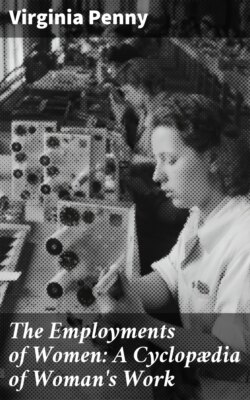Читать книгу The Employments of Women: A Cyclopædia of Woman's Work - Virginia Penny - Страница 18
На сайте Литреса книга снята с продажи.
12. Editresses.
ОглавлениеTable of Contents
The most powerful instrument for disseminating general knowledge in the United States is the newspaper press. It does a great deal for promoting a love of letters; and the cheapness of the papers is such as to render them accessible to almost every one. The literature of the day penetrates the most remote corner of our country. Obscure, indeed, is the place that knows not the printer's power. Even in California, more than a year ago, there were published 81 newspapers. In New York city alone were published 154 newspapers, and 114 magazines. But this is not strange when we remember that no less than eighty languages are spoken there. A newspaper states that there are printed in Austria 10 newspapers, 14 in Africa, 24 in Spain, 20 in Portugal, 30 in Asia, 65 in Belgium, 85 in Denmark, 90 in Russia and Poland, 320 in other German States, 500 in Great Britain, and 1,800 in the United States. Taking merely newspaper and magazine literature into consideration, does not our republic offer inducements to intellectual culture? Does she not reward talent and encourage industry? Yes. Her general diffusion of knowledge and the learned men of her press give a positive reply. The dignity of man should be elevated, his affections purified, and his pursuits ennobled by the mighty influence of the press. Editors should live as ministers to the welfare of humanity. The aspiring character of our people and their thirst for knowledge will long make a heavy demand on the talent and taste of those who wield the editor's pen. There are several publications in the United States conducted exclusively by ladies; some in which the assistant editors are ladies; and a small number devoted to the interests of women alone. Several ladies have entered the editorial corps within the last few years. The Harpers, in their Magazine, state there are about six hundred literary and miscellaneous periodicals published in this country. If all the labor, as type setting, binding, &c., was done by women, what a fortunate thing it would be for many of the poor! I have been told that when an article is sent to a newspaper, and is known to have come from the brain and the pen of a woman, ten to one, her compensation will be smaller for it, and in many cases it will be rejected. There are a few exceptions. Fanny Fern, for instance, receives, we have seen it stated, at the rate of $100 a column from Mr. Bonner for a contribution to the Ledger. The sum total he will pay her for the amount he has engaged will be $6,000. Mrs. B. receives $600 for editing a monthly paper. Some time back contributors to the Independent were paid $3 a column, and to the New York Observer at the same rate. Mr. L. told me that a man is paid $20 a week for making out an index for the New York Tribune, which could be done by any lady with a cultivated and well disciplined mind. The man that was employed not long since had been a wood engraver, and had received no special training for his duties in the Tribune office. The papers to be sent away are directed by machinery, which a lady could attend. Some one writes me the qualifications for his business are strength of mind and body. We think there is generally a heavy draft on either one or the other in every occupation successfully pursued, and in some on both. Émile Girardin was a French editress that died recently. Mrs. Johnson, of Edinburgh, was for years editress of the Inverness Courier, which was published in her husband's name. Miss Parkes conducts the Englishwoman's Journal. Mrs. Swisshelm edited the Pittsburg Visitor with much vigor and ability. Mrs. Virginia L. French has charge of the literary department of a paper issued in Nashville, Tenn. Miss McDowell might have succeeded with the Woman's Advocate, if her noble efforts had been appreciated as they deserved.
